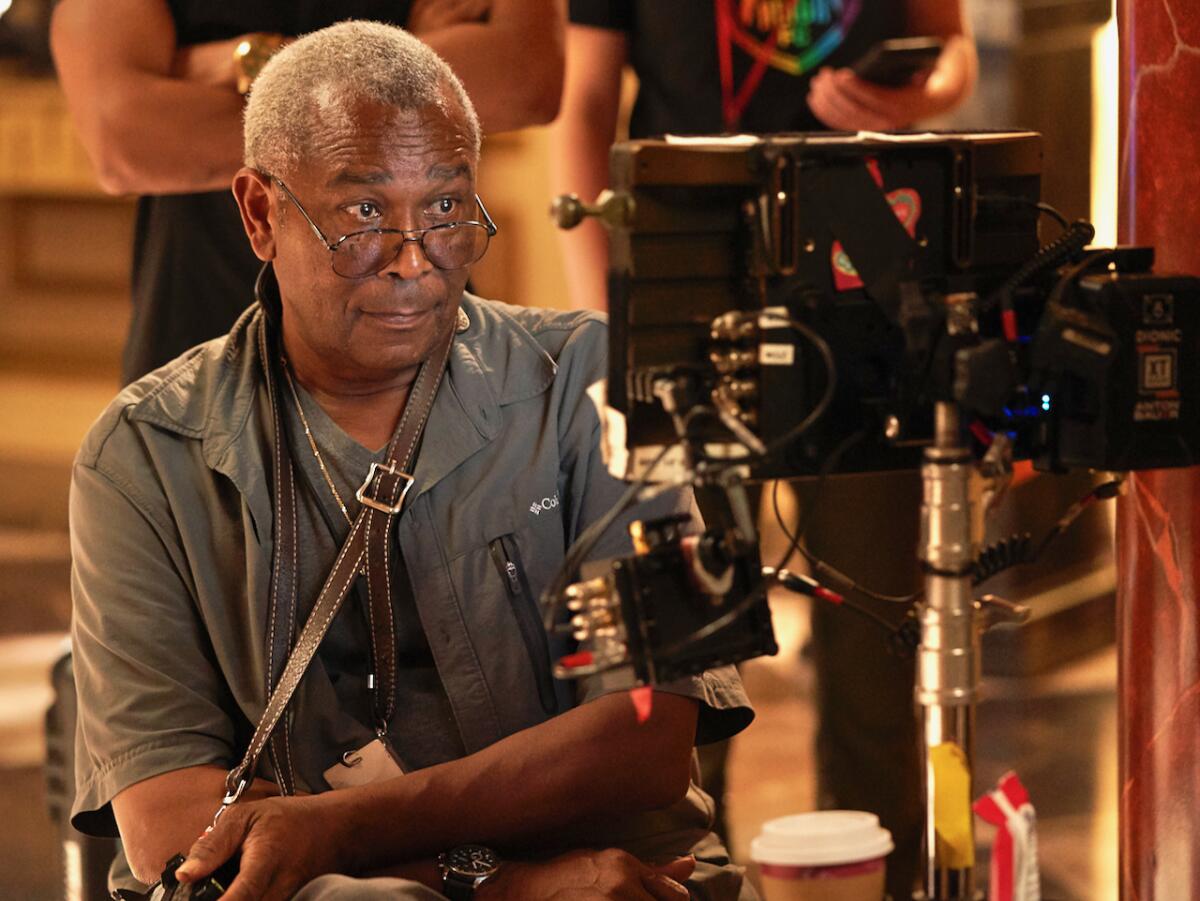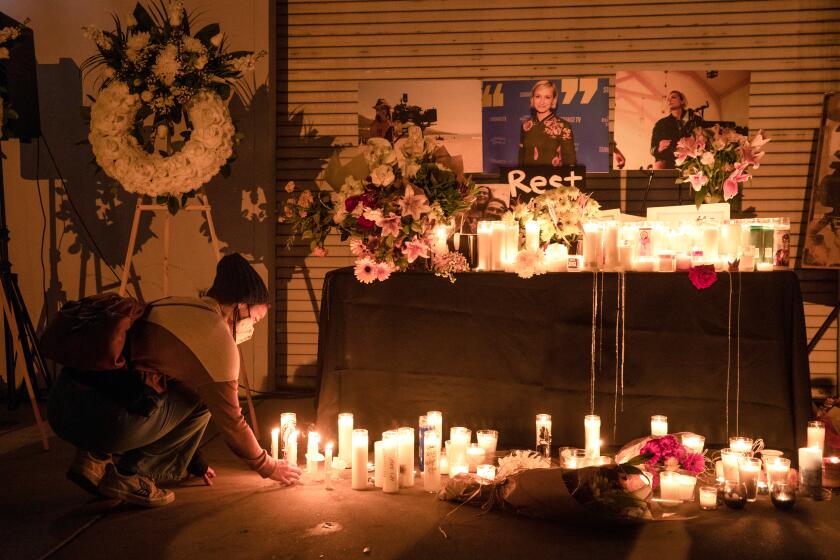Fights over contract, long hours divide cinematographers’ union

Rebecca Rhine recently announced that she would be stepping down as national executive director of the International Cinematographers Guild when her contract expired in September.
In a letter to colleagues, Rhine cited her concerns about mistrust and infighting within Local 600 of the International Alliance of Theatrical Stage Employees.
“Building a stronger union requires patience, collaboration, and hard work,” Rhine wrote in her letter this month. “That means instead of posting about how it should be done, do something. That means if you are going to talk about what is wrong, offer some ideas for how you think it could be done right.”
Rhine’s announcement came in advance of an election last week that brought in a new leadership and highlighted divisions inside the biggest local representing film and TV crews.
Members have clashed over a controversial new contract with studios, COVID-19 closures and restrictions and a generational divide that has surfaced inside other Hollywood unions as well.
“There’s a national mood of anger, mistrust and demolition,” outgoing local President John Lindley said in a recent interview.
One of the biggest sources of tension has been over the union’s most recent contract, which was narrowly ratified by IATSE members in November and averted a threatened walkout.
Lindley and Rhine took heat for urging members to vote in favor of the agreement with the Alliance of Motion Picture and Television Producers that included increases in pay and guaranteed weekend rest terms for those in Local 600 and other IATSE locals.
Although the contract was approved by a majority of IATSE members, a narrow majority of Local 600 members rejected it, believing it didn’t go far enough to address longstanding concerns about grueling hours on film sets.
Those concerns were magnified by the death in October of Halyna Hutchins, a cinematographer who was fatally shot on the New Mexico set of “Rust” by a prop gun fired by actor-producer Alec Baldwin. Before the accident, members of the camera crew had complained to producers of unsafe working conditions, long hours and waiting for their paychecks.
“There’s a disconnect between leadership and rank and file members,” said L.A.-based Sam Petrov, a 26-year-old digital imaging technician who joined Local 600 in 2017 and is co-chair of its young workers group.
“What happened was leadership thought [that] they did a good job and [that] everything happened as it should have,” added Petrov, who was elected to the board last week. “But the difference of opinion is the present-day member perception that a union is so much more than just bargaining contracts: It’s about how you strategize and communicate with your members, along with how your members feel, especially with respect to sentiment coming out of a contract discussion.”
As membership has expanded, so too have divisions between older and younger members, who are pressing their union to take on a more activist role.
“There are many new members in Local 600 now that have never been through the process of negotiations,” said cinematographer and three-term former local President Steven Poster, who agreed with Lindley that the recent contract was the best in decades. “These newer members are very enthusiastic, and they are much more engaged than most members have been in the past, and that’s very exciting, but they have not experienced the process of negotiations and [that] has led to disappointment.”
Local 600 represents 9,000 members, including directors of photography, camera assistants, visual effects supervisors and publicists.

On Friday, members elected Baird B. Steptoe Sr. as national president. The first camera assistant is the local’s first Black president and only the third who is not a cinematographer. He beat out two other incumbent candidates for the position; if confirmed by the board, he will take office in mid-June.
Steptoe did not respond to a request for comment, but he said in his candidate statement, “To be effective leaders, we must listen and understand what our members’ needs are — reaching out to all classifications and hiring more field reps across the country.”
Although Steptoe had advocated for the proposed three-year deal last fall, he campaigned on uniting the membership with those in other locals to fight for safer working conditions, higher wages and benefits with the next round of bargaining looming.
He highlighted his chairmanship of the on-set shop steward training program, which gives workers greater representation at work. He also co-chaired the local’s inclusion committee.
Local 600 is not the only chapter of IATSE to see leadership change in recent months. In November, Los Angeles-based art department coordinator Crystal Hopkins stepped down as president of Local 871, which represents some of the lowest paid members of the union. In December, veteran Local 80 leader Thom Davis, resigned after his unit voted against the deal.
In an interview from Chicago, where he is working on the Hulu series “Justified,” Lindley said he wasn’t running again because he had achieved what he wanted to already and wanted to get back to his day job.
“I was disappointed that some of my members didn’t trust my judgment enough to go along with my recommendation that they ratify the contract, but that’s not the reason I didn’t run,” said Lindley, 70.
“I had been working for well over 20 years on some issues of safety that really matter to me, especially unsafe hours, and when the new contract achieved a weekend turnaround for the first time... I really had gotten done a lot of what I came to do. I’m a cinematographer first, elected labor leader second,” he said.
Lindley, whose credits include the TV series “Castle Rock” and “Unbelievable,” was elected in March 2020, just days before the industry shutdown because of the pandemic. Lindley took over from Lewis Rothenberg, who had resigned just eight months after being elected in a dispute over whether he met residency requirements.
Lindley said he and Rhine have continued to work on other issues, including supporting state legislation to bolster on-set safety in the wake of Hutchins’ death.
Lindley had been working on a production in L.A. when he got a text message that one of his union’s members had been shot on a film set. Then the news came that Hutchins, a rising star in the world of cinematographers, had died, leaving behind a 9-year-old son.
“It was shortly before Thanksgiving and not that far from Christmas, and all I could think about was this kid, for who those two holidays will always mean the loss of his mother,” Lindley said.
Rhine and Lindley attended vigils in New Mexico and L.A., and Lindley said he spoke with Hutchins’ husband to offer the support of the local.
The death of a respected cinematographer during filming of a western in New Mexico has renewed calls for greater safety measures on film sets.
Although there had been disputes on set between the camera team members of Local 600 and the “Rust” movie production company, Lindley said the local had not been notified of any safety issues.
Hutchins’ death tapped into anger over crews’ complaints of lack of rest and dangerous working conditions. That mood still exists, he said.
“There were a lot of members in my union who were angry and upset about many, many things, and the lightning rod for that became the contract ratifications,” Lindley said.
More to Read
Inside the business of entertainment
The Wide Shot brings you news, analysis and insights on everything from streaming wars to production — and what it all means for the future.
You may occasionally receive promotional content from the Los Angeles Times.












